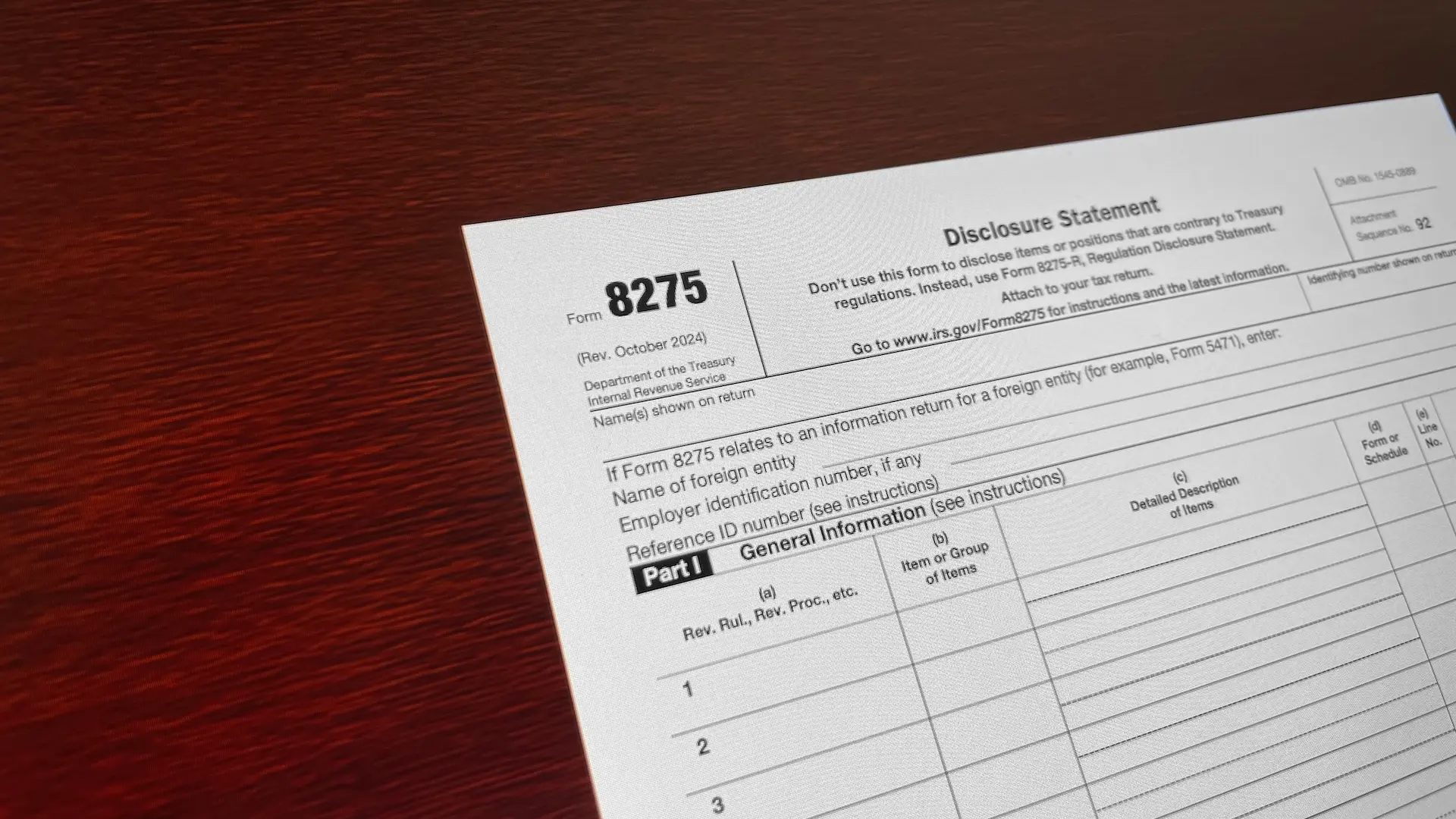Imagine bleeding six figures in cash over a single IRS penalty – money that should’ve stayed in your business, funding your next hire or growth push. For a $2–$20 million business, one tax mistake can tank a quarter’s worth of progress. And here’s the kicker: it’s often avoidable.
If your CPA or CFO isn’t talking to you about Form 8275, you’ve got a problem. This form exists for one reason – to protect you from penalties when you take a legitimate but aggressive tax position. And right now, most business owners are flying blind.
Here’s how to use this form to shield your cash flow, protect your downside, and stay aggressive with your tax strategy – without waking up to a surprise letter from the IRS.
What Is IRS Form 8275 (and Why It Matters)
Form 8275, Disclosure Statement, is a tool to protect you from penalties when you take a tax position that’s in a gray area – meaning there’s no “substantial authority” backing it up.
In plain English: you’re telling the IRS, “We took this position. Here’s why. We’re not hiding anything.”
That disclosure matters. Because if the IRS disagrees and you didn’t file Form 8275, you’re on the hook for back taxes plus a 20% penalty on the underpaid amount.
For a $10M business with an aggressive $250K deduction that gets disallowed, that’s a $50K penalty. That penalty doesn’t build your business. It doesn’t cover payroll. It’s just gone – because no one filed a two-page form.
What Happens If You Don’t Use It
Let’s be blunt: skipping Form 8275 when you should’ve filed it is reckless.
Hefty Penalties That Drain Growth Capital
Say your company claims a $200K deduction that isn’t crystal clear. If the IRS disallows it and you failed to disclose, you’re not just paying the ~$60K in tax. You’ll owe an additional $12K penalty. That’s $12K in pure waste – money that could’ve funded new hires or equipment upgrades.
Interest Charges & Longer Audit Windows
It gets worse. You’ll also pay interest on the underpaid tax. And if the issue qualifies as a “substantial understatement,” the IRS can double the audit window – from 3 years to 6. That’s half a decade of uncertainty, hanging over your books.
CPA Liability & Relationship Fallout
If your CPA knew the position was aggressive and didn’t disclose it, they can get penalized too. That strains the relationship and often causes CPAs to go overly conservative on future returns – leaving tax savings on the table. Filing Form 8275 protects everyone.
You Lose Control of the Narrative
The IRS doesn’t care if your intent was good. If you didn’t disclose, you look like you were hiding something. That’s how you end up triggering deeper audits, penalties, and reputation risk.
When to Use Form 8275
Use Form 8275 any time you’re taking a position that:
- Lacks clear legal support
- Involves aggressive deductions or credits
- Involves unusual income classification
- Could be questioned by the IRS
Let’s break down a few real-world examples.
1. Gray-Area Deductions or Credits
Maybe you’re writing off a large software build under Section 174, or taking an R&D credit where eligibility is debatable. Disclose it. If the IRS later disagrees, you’ll pay the tax – but skip the 20% penalty.
2. Unusual Income Treatments
Received a legal settlement and excluded it from income? Claimed a grant as non-taxable? If there’s any risk the IRS sees it differently, Form 8275 is your way of showing you had a reason – and weren’t trying to pull a fast one.
3. Strategic Entity Moves or Elections
Took a rare tax election? Structured a deal to optimize treatment? Claimed a home office deduction for a mixed-use space? If your CPA says “this could go either way,” that’s your signal to file.
4. Pass-Through Entity Risks
If you’re in a partnership or S corp, and the entity takes a questionable position that flows to your return – file Form 8275 yourself. Ideally the entity files it, but you can protect your end with your own disclosure.
How to Use It Properly
1. File It with the Original Return
Do not wait to see if the IRS calls. Form 8275 needs to go in with the initial return. Most professional software allows it to be attached as a PDF for e-filed returns.
2. Be Clear and Concise
In Part II, explain what you did, the dollar amount involved, and the legal rationale. Include references: IRS code sections, revenue procedures, court cases – whatever supports your position. Don’t write a novel. Just lay it out clean.
Example:
“Company deducted $50,000 in software dev costs as Section 174 expenses. Position based on Rev. Proc. 2000-50 and Tax Court decision in XYZ v. Comm’r. Disclosure made to preserve reasonable basis protection.”
3. Use the Right Form
Use Form 8275 for positions not directly contradicting IRS regulations. If you’re going against a regulation, use Form 8275-R. Most of the time, the standard 8275 will do.
4. File Multiple Forms if Needed
If you’ve got several questionable positions, use multiple forms – one per issue. Keeps the disclosures clean and focused.
5. Keep Your Backup
Form 8275 is a summary. Keep the full documentation ready to go: legal memos, emails, notes. If you get audited, you’ll need to prove you had a reasonable basis.
A Real Example: How One Business Saved $20K with a Single Form
A marketing agency treated a six-figure revenue item as a capital contribution due to the nature of the deal. The tax savings? $100K.
The owner disclosed the position using Form 8275.
Two years later, the IRS challenged it. He owed the tax, plus interest – but no penalty. That’s a $20,000 win for two pages of paperwork.
If he hadn’t disclosed? That same tax savings would’ve cost him an extra $20K in penalties.
How to Use Form 8275 as a Strategic Advantage
1. Keep More of Your Cash, Safely
Sometimes the tax law is unclear. That doesn’t mean you shouldn’t pursue the savings – it means you should do it smart. Form 8275 lets you play offense without gambling with your cash flow.
2. Maintain Good Standing with the IRS
Filing Form 8275 shows you’re not being shady. The IRS isn’t out to get you if you’re upfront. Full disclosure improves audit outcomes and keeps issues contained.
3. Contain the Scope of Audits
If you disclose, the IRS tends to focus on that item. If you don’t and they discover something? Expect them to start digging. One red flag turns into an audit fishing expedition. Disclosure protects your time and mental bandwidth.
4. Use It as a Planning Checkpoint
Ask your tax team every year: “Do we need any Form 8275s this year?” If the answer is always no, start questioning if you’re missing opportunities. This form should show up in real tax planning, not just compliance.
Link to download the official form: https://www.irs.gov/forms-pubs/about-form-8275
Bottom Line
Form 8275 is not about being clever. It’s about being strategic.
You don’t grow a company by overpaying tax and praying the IRS doesn’t notice a gray area. You grow by taking strong positions with protection in place. And this form gives you that protection.
If your accountant isn’t using it – or doesn’t know how – then it’s time to upgrade your tax team.
Want to build a tax strategy that protects your downside while unlocking real savings?
We do this every day for high-growth businesses. Book a consultation today.


